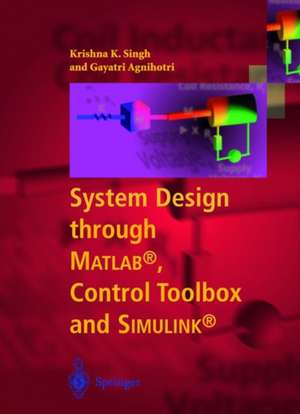System Design through Matlab®, Control Toolbox and Simulink®
Autor Krishna K. Singh, Gayatri Agnihotrien Limba Engleză Paperback – 29 sep 2000
Preț: 542.87 lei
Preț vechi: 638.67 lei
-15% Nou
Puncte Express: 814
Preț estimativ în valută:
103.88€ • 108.96$ • 86.48£
103.88€ • 108.96$ • 86.48£
Carte tipărită la comandă
Livrare economică 01-15 aprilie
Preluare comenzi: 021 569.72.76
Specificații
ISBN-13: 9781852333379
ISBN-10: 1852333375
Pagini: 512
Ilustrații: XXIV, 488 p. 372 illus.
Dimensiuni: 170 x 244 x 27 mm
Greutate: 0.84 kg
Ediția:1st Edition.
Editura: SPRINGER LONDON
Colecția Springer
Locul publicării:London, United Kingdom
ISBN-10: 1852333375
Pagini: 512
Ilustrații: XXIV, 488 p. 372 illus.
Dimensiuni: 170 x 244 x 27 mm
Greutate: 0.84 kg
Ediția:1st Edition.
Editura: SPRINGER LONDON
Colecția Springer
Locul publicării:London, United Kingdom
Public țintă
Professional/practitionerCuprins
1. System Representation and Modeling.- 1.1 Properties of the Models.- 1.2 Creating a Model.- Exercise for Chapter 1.- 2. Model Manipulation.- 2.1 The Precedence Rule and the Law of Property Inheritance.- 2.2 Arithmetic Operations on Models.- 2.3 Interconnection of Models.- 2.4 The Linear Time Invariant (LTI) Subsystem.- Exercise for Chapter 2.- 3. Getting Information from the Models.- 3.1 Model-specific Information.- 3.2 Direct Property Referencing Method of Getting Information.- 3.3 The ‘get’ Function.- 3.4 Information about Model Dimensions and Characteristics.- 3.5 Conversion of Models.- 3.6 A Few Words on Model Properties Again.- Exercise for Chapter 3.- 4. Model Analysis.- 4.1 Model Dynamics of Control System.- 4.2 Time Response Analysis of Control Systems.- 4.3 Frequency Response Analysis of Control Systems.- 4.4 State Space Analysis of Control Systems.- Exercise for Chapter 4.- 5. The Control System Toolbox’s GUIs.- 5.1 The LTI Viewer.- 5.2 The Root Locus Design GUI.- Exercise for Chapter 5.- 6. Control System Design through Simulink®.- 6.1 System Representation/Modeling.- 6.2 Model Manipulation.- 6.3 Model Analysis.- 6.4 The Simulink® LTI Viewer.- 6.5 A Few Words of Caution.- Exercise for Chapter 6.- 7. Design of Compensators for Systems.- 7.1 Classical Methods for Design.- 7.2 Solution of Lyapunov’s Equation and Stability.- 7.3 Modern Methods for Design.- 7.4 Design of Optimal Compensators.- Exercise for Chapter 7.- 8. Some Simple Applications.- 8.1 Which Method to Choose.- 8.2 Electrical Systems.- 8.3 Mechanical System.- 8.4 Fluid Systems.- 8.5 Thermal Systems.- Exercise for Chapter 8.- 9. Some Complex Applications.- 9.1 DC Motors.- 9.2 Plunger System.- 9.3 Power-generating Systems.- 9.4 Power-plant System.- 9.5 Pacemaker System.- 9.6Inverted-pendulum-on-cart System.- 9.7 Essential-oil-extraction Plant.- 9.8 Musical-octave System.- Exercise for Chapter 9.- Appendix A.- Appendix B.- Appendix C.- C.l Plotting some Typical Signals.- Appendix D.- D.l Plotting some Typical Signals.- Appendix E.- References.
Caracteristici
MATLAB is now an essential tool of most engineers MATLAB is a complicated application and users like help - the more basic the better Includes supplementary material: sn.pub/extras




